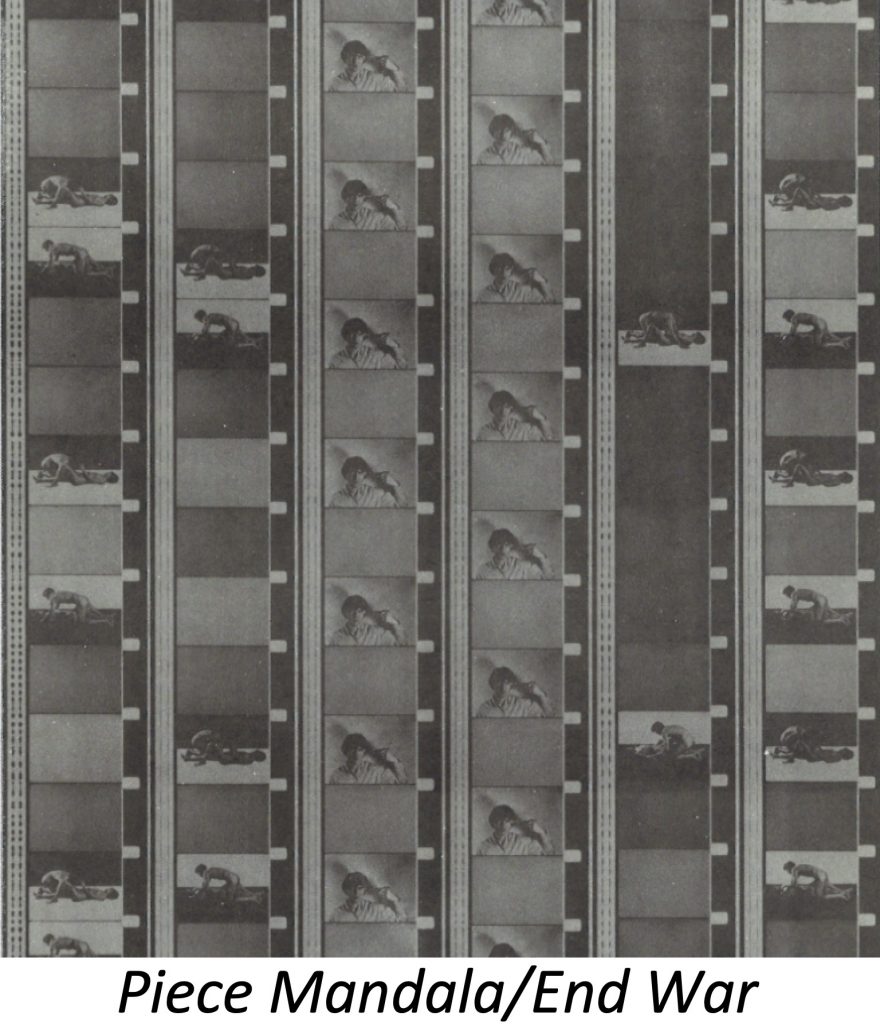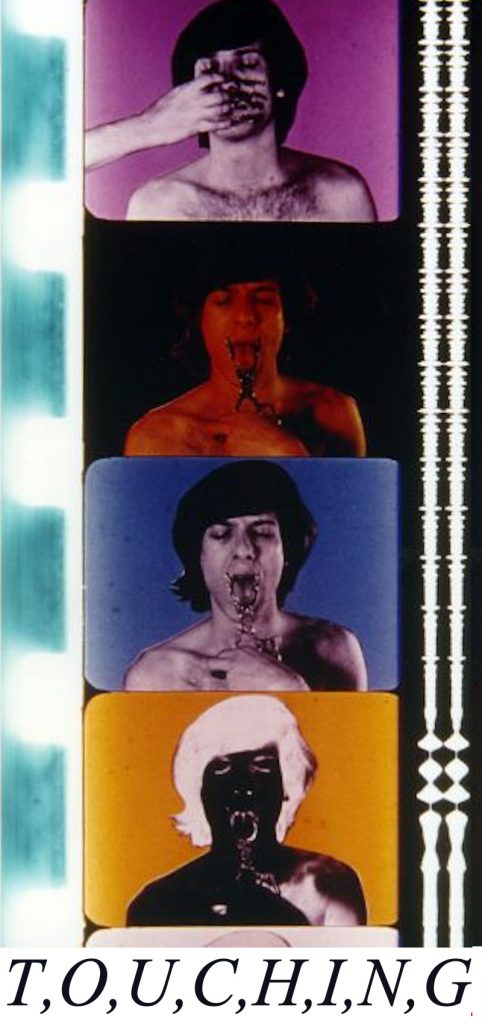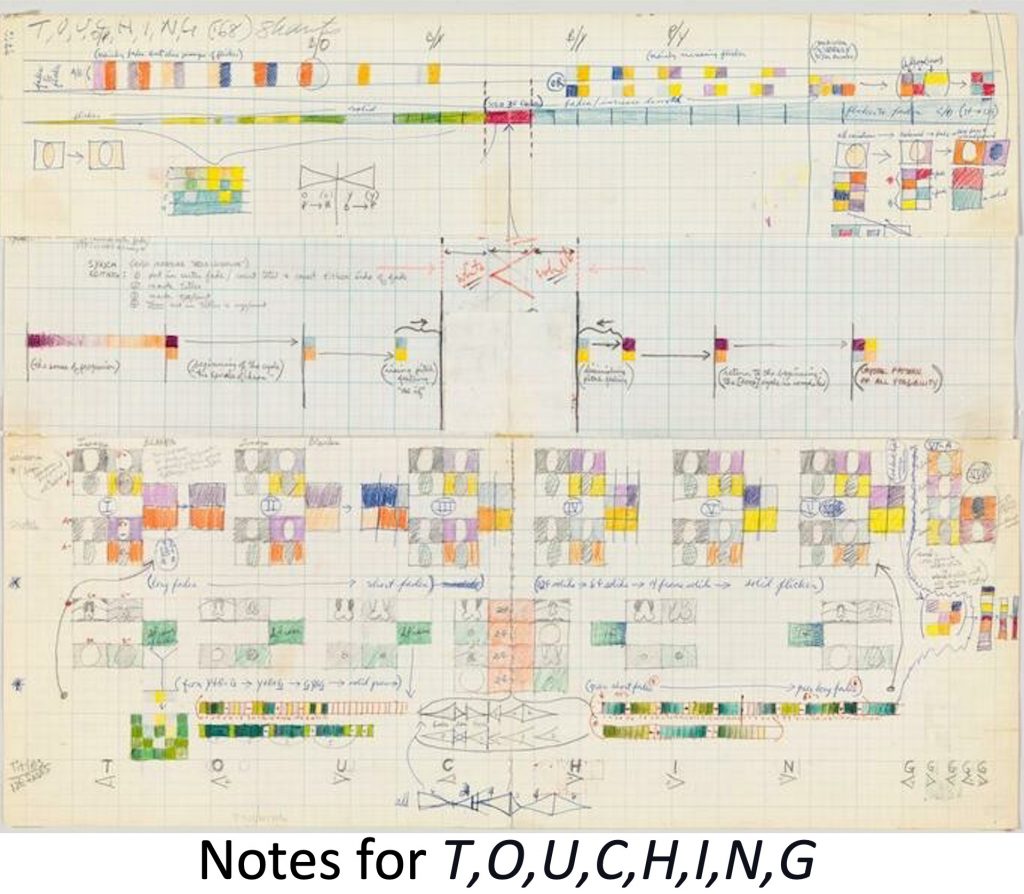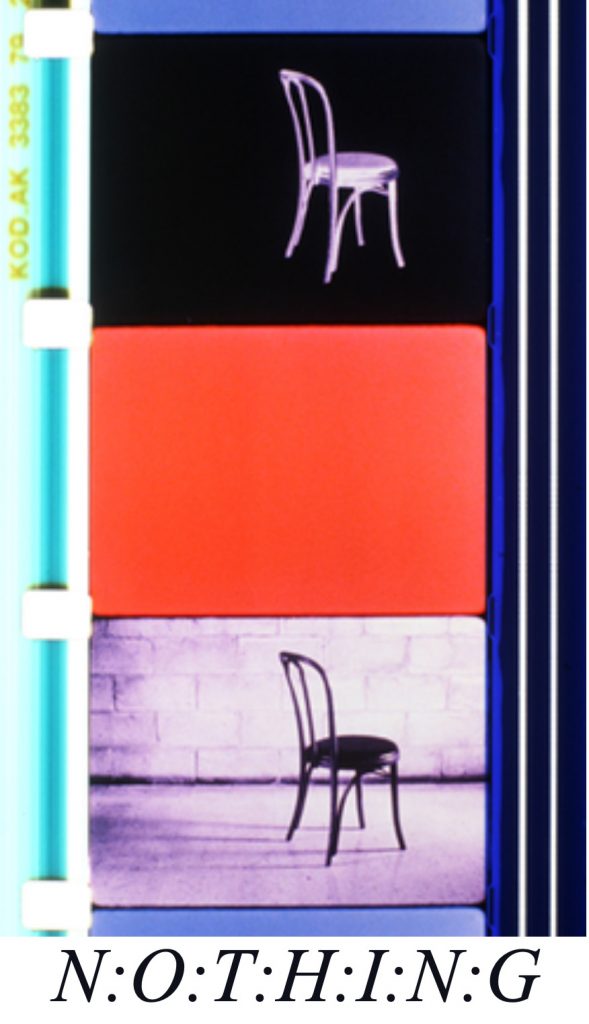Paul Sharits (1943-1993) was an American film artist, a proponent of what Peter Gidal, P. Adams Sitney, and Anette Michelson referred to as “structural film” (Sitney 2002, 348). This 1960s avant-garde film movement foregrounded a film structure ahead of its content. Sharits was trained as a graphic artist and painter. His 16mm films were concerned with flicker, abstract light plays that created visceral perceptual effects both in sound and image that have been taken up more recently in the expanded proto-cinema of Bruce McLure. These films were often multi-projector. Shutter Interface (1975) consists of four 16mm projectors with four soundtracks on a continuous loop. His flicker films include Ray Gun Virus (1966), Piece Mandala/End War (1966), N:O:T:H:I:N:G (1968), and T,O,U,C,H,I,N,G (1969), which are the main focus of this discussion.
Sharits’ animation practice focuses on a pauce palimpsest of repeated imagery. Single frames intermittently flash on the viewer’s retina. Sharits’ films play with and extend the principle of the persistence of vision, a perceptual effect that lies at the base of 16mm film projection. What is materially available on the film strip is very different from what is perceived by the viewer. These technologically specific artifacts are not available in the same way in digital copies of these films. This may explain why Sharits’ previously prominent work has disappeared from public view since the establishment of competent digital projection technologies.
Sharits’ films and installation works were influenced by the emergent Information Theory of Abraham Moles (see 1968). Sharits also had an interest in neurological research and created numerous tables or graphs of his films that transcribed their repetitive patterns into a visual field. His practice is framed in this examination through Vilem Flusser’s Technical Image (Flusser, 2000), Marshall McLuhan’s four laws of media (McLuhan, 1988), and McLuhan’s theorizing on acoustic space (Cavell, 2002).
In Paul Sharits’ own words:
“I wish to abandon imitation and illusion and enter directly into the higher drama of: celluloid, two-dimensional strips; individual rectangular frames; the nature of sprockets and emulsion; projector operations; the three-dimensional light beam; environmental illumination; the two-dimensional reflective screen surface; the retinal screen; optic nerve and individual psycho-physical subjectivities and consciousness” (Sharits 1969, 13).
Ray Gun Virus consists solely of flickering and rapidly altering coloured frames accompanied with the sound of the sprocket holes going through the projector, which adds to the staccato rhythm of the film. The viewer is left to focus on the film physically going through the projector gate at 24 frames per second and the unitary nature of every frame of film. Over time, visually the viewer’s focus shifts to the screen and the material that seems to hover above it. Aurally the viewer stays with projector’s sound trace. This audio-visual dialogue constructs an event that performed Sharits’ idea of “cinematics”.

In Piece Mandal/End War, the top and bottom half of the frame alternates between black and white with flashing superimposed images of Sharits and his wife performing sexual intercourse. Flicker adds dynamism to these photographs. At its midpoint an image of Sharits holding a gun to his head is introduced, which persists to the point of sexual climax in the intercourse series, graphically building a tension between love and death.

In T,O,U,C,H,I,N,G, single frames of poet David Franks flash on and off amongst clusters of flickering colored frames. These images show the poet cutting off his own tongue with a pair of scissors, or scratching across his face. These positive and negative flashes produce afterimages that persist beyond the actual celluloid frame in which they physically reside. The soundtrack stammers and loops the word “destroy”, which through its many repetitions drifts to suggest other words that are similar or related. It is the perceptual apparatus, the physicochemical system of vision, by which these packets of information are received that is orchestrated by Sharits’ film. It is not only the film, but the act of viewing that becomes the film’s subject. Its images are arranged rhythmically more like a musical score or computer script than the structure of a narrative film.


In N:O:T:H:I:N:G, amongst the structured flickering colour frames also present in the other films, there appear images of a toppling wooden chair, which in its final manifestation is on the ground. Graphic images of a light bulb with dashed lines indicating light rays also appears. Towards the film’s end the light rays disappear and the light bulb’s contents pour out from the bottom. It becomes apparent that these clusters of flickers have been highly programmed, organized, mapped out, and planned before they have been shot. There are a number of filmstrip images of Sharits films that make these rhythms and spacings apparent, which double as a summary of the film much better than any liner note summary as I have attempted here.
Sharits evolved his concept of “cinematics” through his research on flickering, single frame image clusters, colour and their rhythm. He preferenced “cinematics” over “cinema”, whose illusion, narrative and representational strategies he eschewed. Despite the aural behaviour of his flicker effects and rhythms, Sharits himself further located his animations outside the visual music genre exemplified by such animators as Oskar Fischinger, Norman McLaren and Steven Woloshen. “Cinematics” is based on an interest in a philosophy of mathematics and its relation to language which Sharits sourced through composer Iannis Xenakis and Ludwig Wittgenstein’s philosophy.
Sharits’ language behaved sonically at the level of the frame. Afterimages, flicker, and color composed a sonic field float and shift above the projector screen. Rather than with a musical score these structures had more in common with the logics of the computer program that Vilem Flusser places at the base of the “technical image” (Flusser, 2011). Sharits’ approach can be understood as being in transition between these two musical and mathematical models, remaining an amalgam of both. The colors and their abrupt shifts were based on algorithmic patterning of its orchestrated hues. These perceptual artefacts further relate back to the perceptual impact of Mark Rothko’s colour fields on the body and Maurice Merleau-Ponty’s phenomenological approach to vision:
My field of perception is constantly filled with a play of colours, noises and fleeting tactile sensations which I cannot relate precisely to the context of my clearly perceived world, yet which I immediately place in the world without ever confusing them with my daydreams (Merleau-Ponty 2013, x).
In Sharits’ move towards mathematics in “cinematics” the social becomes quantifiable. This will later draw Sharits to Abraham Moles’ writings on an emergent Information Theory which asserts that ‘all behavior, present and future of the individual may be described with a degree of precision equal to that of a physicochemical system’ (Moles 1968, 3).
References
Cavell, Richard (2002). McLuhan in Space: A Cultural Geography, Toronto: University of Toronto Press.
Flusser, Vilém (2000), Towards A Philosophy of Photography London: Reaktion Books.
Flusser, Vilém (2011). Into the Universe of Technical Images, trans. N.A.Roth, Minneapolis–London: University of Minnesota Press.
McLuhan, Marshall and Eric McLuhan (1988). Laws of Media: The New Science. Toronto: University of Toronto Press.
Merleau-Ponty, M. (2013). Phenomenology of Perception, trans. Landes D. A., London: Routledge.
Moles, Abraham (1968). Information Theory and Aesthetic Perception, trans. J. Cohen, Chicago: University Illinois Press Urbana.
Sharits, P. (1969). ‘Notes on Films’, Film Culture, 47, pp.13-16.
Sitney, P. Adams (2002). Visionary Film: The American Avant-Garde 1943-2000, 3rd Edition, Oxford: Oxford University Press.
Dirk de Bruyn is Associate professor of Screen and Design at Deakin University, Melbourne, Australia where he teaches Animation and Documentary Animation modules. He has made numerous animations, performance, and installation work over the last 40 years. He was a founding member and past president of MIMA (Experimenta). His book The Performance of Trauma in Moving Image Art was published in 2014. His recent animations, such as Re-Vue (2017), Chanting (2018), Recover (2017), and Living in the Past (2018), have been screened internationally. Retrospective programs of his animations have been presented at Melbourne International Animation Festival (2016), Alternativa, Serbia and Punto Y Raya, Karlsruhe Germany (2016).

What would it cost a person to hire an animation artists to create a one minute phonics song video. It would use an original song with different characters heads with human lips. Each character head will represent each letter of alphabet. Its a song I sang to many children during my teaching career. And would like to turn this song to life and help many non-readers to began to read . The song is entitled ” Letters Makes Sounds and Sounds Makes Words This Is How We Read”.Waiting to hear back for someone thanks.